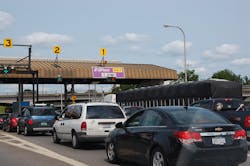President Trump’s call for easing federal tolling restrictions as part of his $1 billion infrastructure plan drew criticism from several trucking and highway groups.
Trump released his fiscal 2018 budget blueprint on May 23, which seeks a 12.7 percent funding cut to $16.2 billion for the Department of Transportation. Included was a section offering further insight into the $1 billion, 10-year infrastructure plan still being finalized.
“The administration’s goal is to seek long-term reforms on how infrastructure projects are regulated, funded, delivered, and maintained. Providing more federal funding, on its own, is not the solution to our infrastructure challenges,” the White House wrote in a fact sheet included with the budget.
The administration said it aims to spend $200 billion over 10 years to generate at least $800 billion in additional state, local and private investment in highways, bridges, airports, sea ports and other facilities. Among the funding proposals was one to “liberalize tolling policy and allow private investment in rest areas.”
“We should reduce this restriction and allow the states to assess their transportation needs and weigh the relative merits of tolling assets. The administration also supports allowing the private sector to construct, operate, and maintain interstate rest areas, which are often overburden and inadequately maintained,” the White House said.
Several groups issued statements critical of that idea.
“We are very concerned about how heavily the Trump administration wants to rely upon public-private partnerships to fund our roads and the idea of loosening the federal restriction on tolling interstate highways,” the Alliance for Toll-Free Interstates said. “As outlined in the proposed budget, leveraging $200 billion public dollars into a $1 trillion transportation plan will only be possible through widespread tolling to produce private sector profits.”
American Trucking Associations (ATA) sent a similar message.
”While ATA is encouraged by the apparent focus on infrastructure investment . . . we are deeply concerned by the proposal to loosen the restrictions on interstate tolling,” said Bill Sullivan, executive vice president for advocacy. "In addition to being inefficient and unsafe, tolling has proven to be deeply unpopular, with states like North Carolina and Virginia abandoning interstate toll projects. Quite simply, time and again, proposals to use tolls to fund highways have failed.”
Conversely, it received a warmer reception from Patrick Jones, CEO of the International Bridge, Tunnel and Turnpike Association.
"Congress should give states access to one more tool in the toolbox by allowing them to toll their interstate highways specifically to rebuild them," he said. "This wouldn't be a mandate; no state would be required to toll their interstates.”
While no funding in the budget was provided for the Transportation Investment Generating Economic Recovery (TIGER) grant program, Trump is seeking the expansion of the Transportation Infrastructure Finance and Innovation Act (TIFIA) program. TIFIA helps finance surface transportation projects through direct loans, loan guarantees and lines of credit.
Additionally, the administration wants to lift the current $15 billion cap for tax-exempt “private activity bonds,” used to help finance public-private partnership deals for highways and freight facilities.
To speed up improvement projects, the administration called for eliminating or reforming regulations, such as environmental reviews.
“The administration will work to streamline and rationalize the permitting process while maintaining opportunities for meaningful public input and protecting the environment,” the White House said.
Other budget highlights included a 31 percent cut for the Environmental Protection Agency, 11 percent cut for the Interior Department and almost 6 percent trim to the Energy Department.
Trump is also proposing to cut the Strategic Petroleum Reserve in half. The sale of the oil could reduce the federal deficit by $16.5 billion over 10 years, according to budget documents.
About the Author
Neil Abt
Neil Abt is a former FleetOwner editor who wrote for the publication from 2017 to 2020. He was editorial director from 2018 to 2020.
